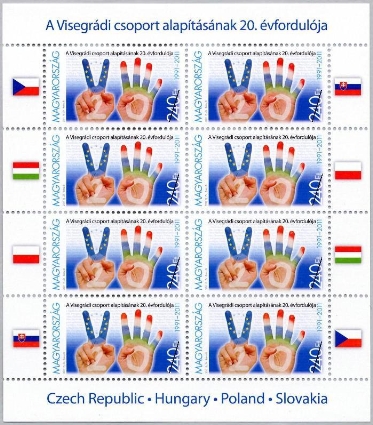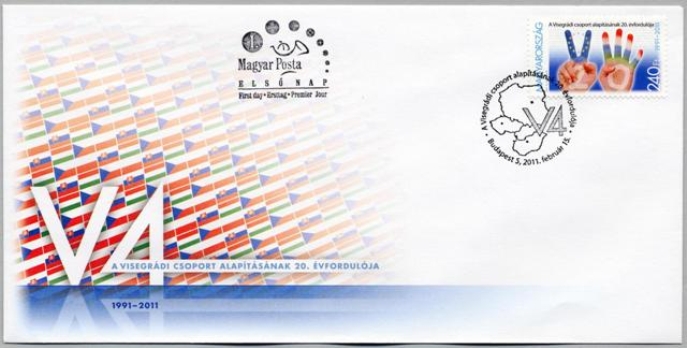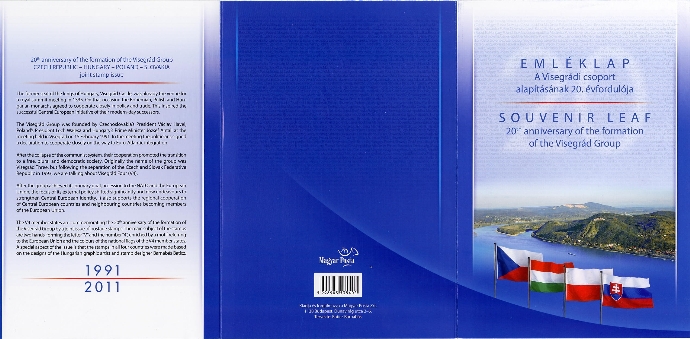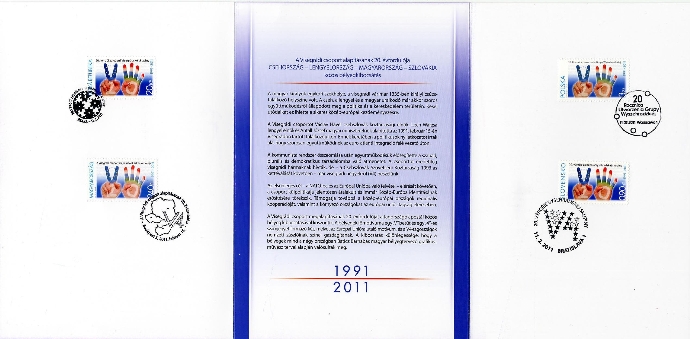Anniversary of the formation of the Visegrád group / Czech, Hungarian, Polish, Slovak joint stamp is
Date of issue: 15 February 2011

The Group is named after the town of Visegrád in the north of
Hungary. In November 1335, on the initiative of the Hungarian king
Charles Robert, a meeting was held in the royal palace in Visegrád with
the Polish monarch Casimir III and the king of Bohemia, John of
Luxembourg. This cooperation was continued on 15 February 1991 when
Czechoslovakia’s President Václav Havel, Poland’s President Lech Wałęsa
and Hungary’s Prime Minister József Antall signed the Visegrád
Declaration. After the dissolution of Czechoslovakia in 1993, it became a
four-member group.
Among the objectives of the 1991
declaration were the elimination of the vestiges of totalitarianism, the
protection of democracy, and the collaboration of the three countries
to promote economic progress and Euro-Atlantic accession. In
2000 the International Visegrád Fund, based in Bratislava, was created,
which is widely thought to be the V4’s most successful venture. It
strengthens cooperation between the member states in culture, science,
research and education, and fosters ties through youth exchanges. Thanks
to the Fund’s budget, applications from the four member states can be
made to the Bratislava Secretariat for grants several times a year. The
Fund’s activities also include providing humanitarian aid. (Source:
visegradgroup.eu hu.wikipedia.org)The main motif of the
stamps marking the anniver-sary are hands forming the letter “V” and the
num-ber “4”, enriched by a motif referring to the European Union and
the colours of the national flags of the V4 member states. The numerals 2
and 0 on the palms of the hands refer to the 20th anniver-sary.

A special aspect of the issue is that the stamps in all four countries have been made based on the designs of the Hungarian graphic artist and stamp designer Barnabás Baticz. On the first day cover there is a graphic composition using the flags of the member states. The postmark employs the contour of the maps of the countries comprising the group. A commemorative card is also being released to present the stamps of the four countries together.


Order code: 2011020010011 (stamp) 2011020060012 (FDC) 2011020040011 (miniature sheet) 4103565 (commemorative card)
Date of issue: 15 February 2011
Face value: HUF 240
Number of copies issued: 50,000 miniature sheets
Perforated size of the stamp: 45 x 26.67 mm (8 stamps/sheet)
Imperforated size of the miniature sheet: 116 x 132.68 mm
Printing method: 4 + 1 colour offset
Printed by Pénzjegynyomda
Designed by Barnabás Baticz


